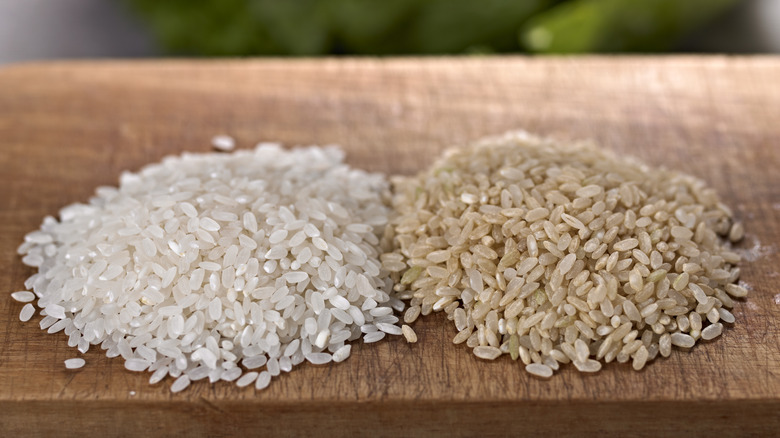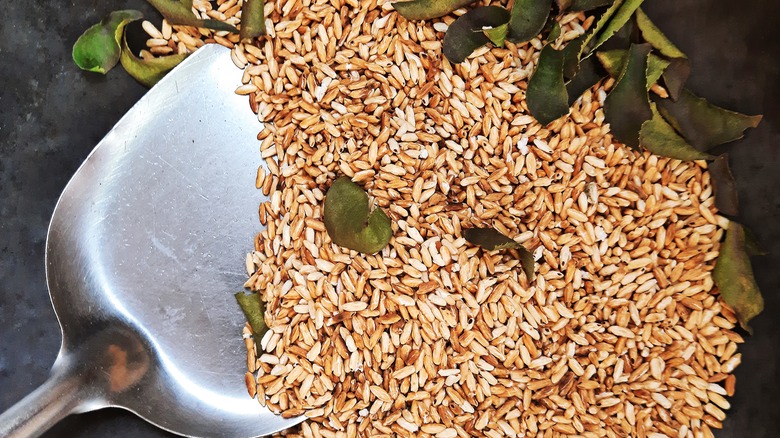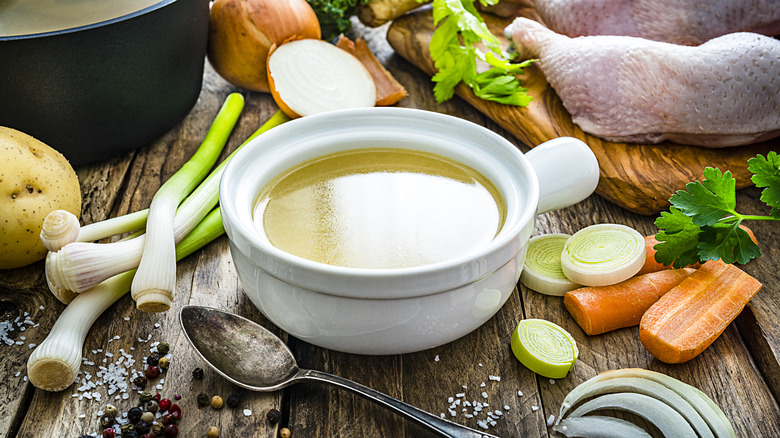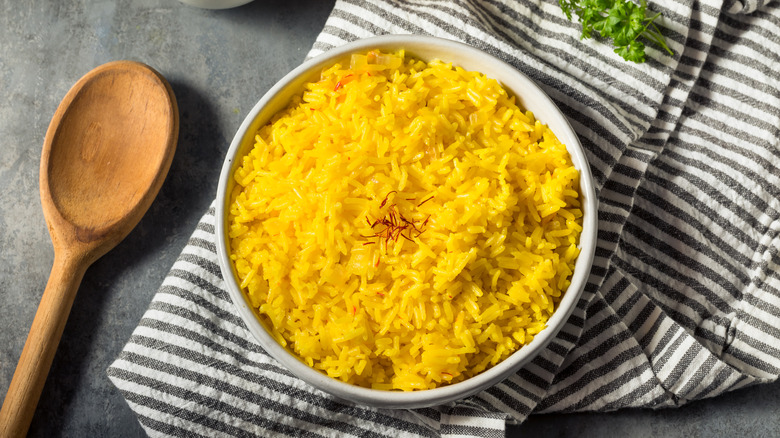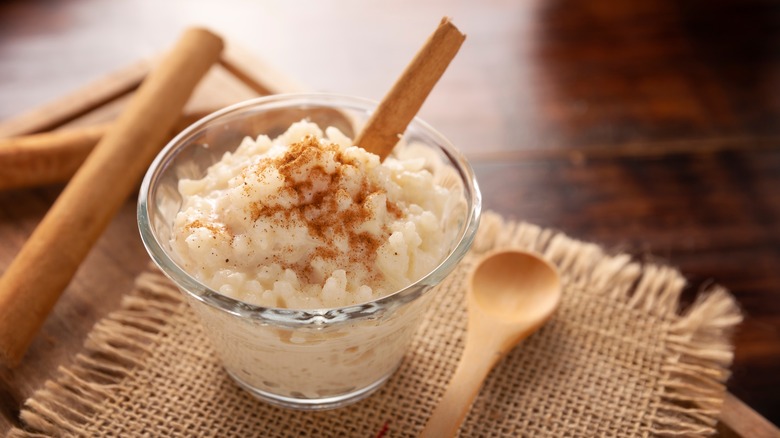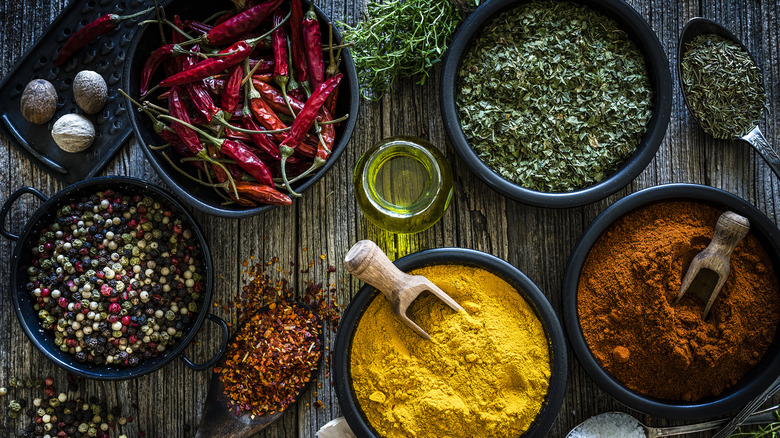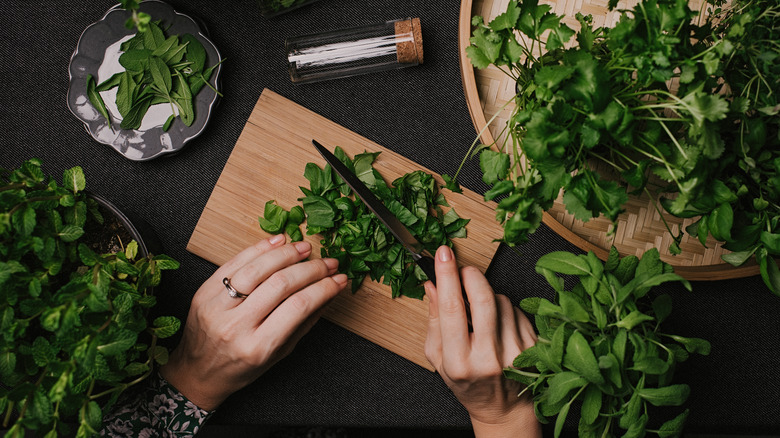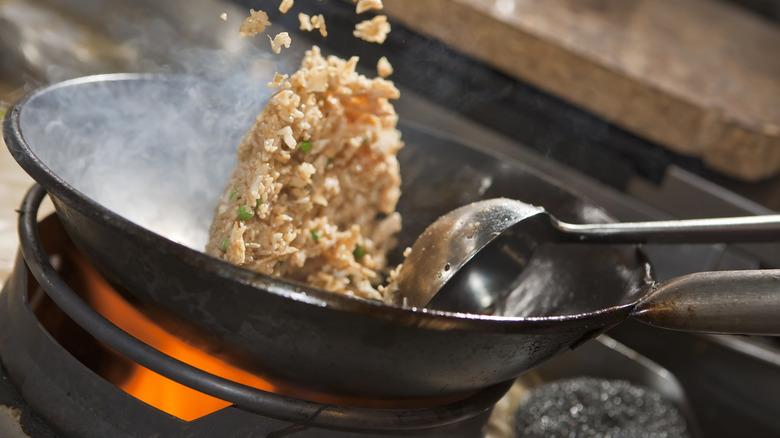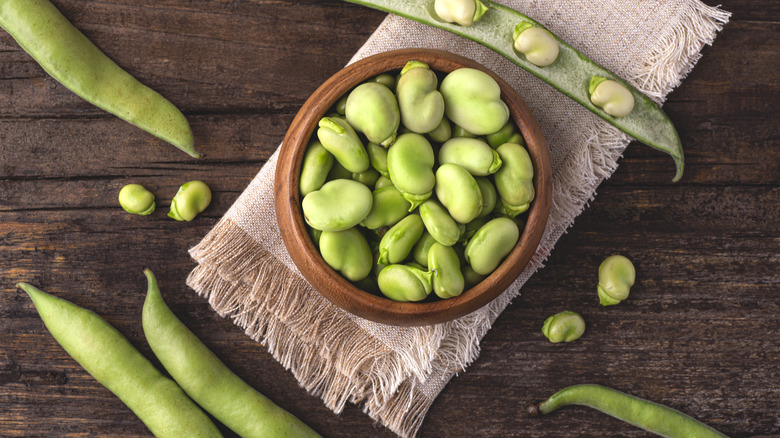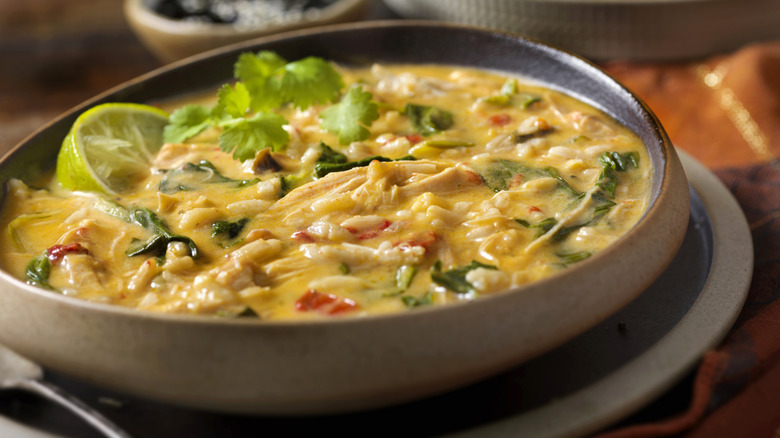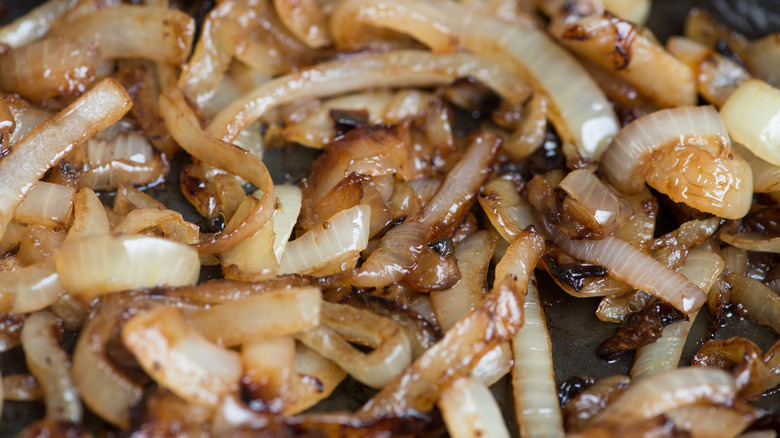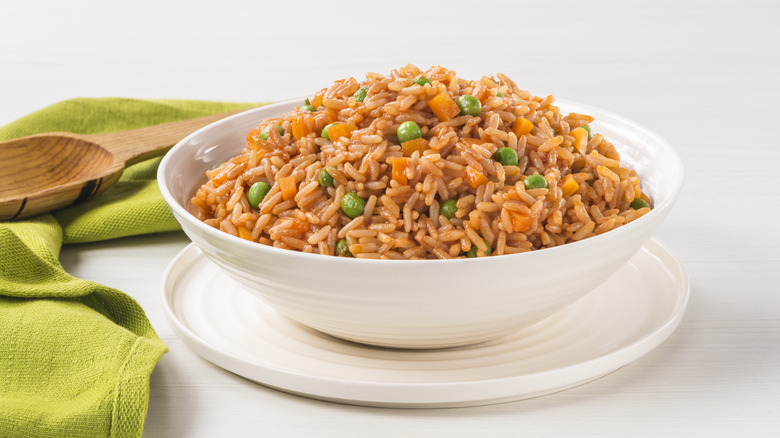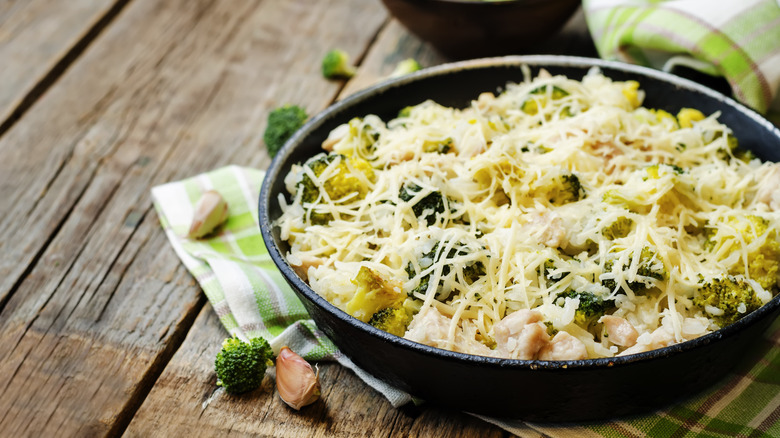12 Tips For Adding More Flavor To Plain Rice
It's no doubt that plain rice deserves its place on the dinner table. Your basic plain white rice becomes a flavor bomb when it soaks up tasty sauces or soups, and plain brown rice is a nutritional powerhouse. There's a lot to love about a humble and fairly affordable staple that enhances the star flavors of the meal while also filling your stomach. But there's just one little problem: Plain rice is generally mild in flavor, and sometimes you want a dish that amps up your taste buds.
What can you do when you want the dependability and heartiness of rice but the yum factor of a more extroverted dish? You jazz it up, of course. Below, we've got 12 suggestions for infusing your plain rice with a little (or a lot) more flavor, and many of them involve ingredients or tools that you may already have in your kitchen.
1. Toast it for a deep nutty taste
Toasting your rice before cooking it adds depth to its natural nuttiness, and that alone might satisfy your need for extra flavor. This is the tip for you if you just want a more pleasant complexity to your rice, not a tweak that sends your meal's entire flavor profile off into a new direction.
The most basic way to toast rice is to pour your desired quantity into a dry saucepan and cook it over medium heat for about five minutes. Be aware that the kernels can burn easily, so pay attention to your senses during this process. Watch for the signs of the rice to take on a slightly brown hue, and keep your nose open for a nutty, warm aroma.
There's a better way to toast rice, courtesy of "Good Eats" host Alton Brown, which involves using a type of fat for added flavor. Butter yields especially delicious results thanks to its milk solids; use just over ½ tablespoon per cup of rice. Oil works great as well. Avocado oil is an excellent neutral flavored option, but if you like to experiment, try one with more personality, such as coconut or sesame oil. Whichever oil you're working with, use about 1 tablespoon for every cup of uncooked rice.
2. Swap the water for stock
Just because the instructions on your bag of rice tell you to cook it in water doesn't mean you have to comply. Boiling rice in stock or broth is an easy way to add a saltier, savory flavor to an otherwise blandish grain. This technique is so effective at enhancing rice that it's a requisite step for rice pilafs and the incredibly delectable Hainanese chicken rice, but it works just as well when the rice is a simple side dish. You can use any type of stock that calls to you, be it homemade or store-bought. Vegetable stock makes for great savory rice, as does chicken or beef stock, which will flavor the dish with their respective meaty bases, so keep this in mind when pairing your rice with a main course.
The ratio for cooking rice in stock is pretty simple: Use a 1:2 ratio of rice to liquid, whether that's water, stock, or broth. If you like to add salt to the water when you cook rice, but due to the sodium content, it's a good idea to omit it when swapping in a stock or broth.
3. Make a fragrant saffron rice
If you want to add a subtle, distinct sweet flavor along with along with a gorgeous hue, why not add saffron to your rice? Saffron is the world's most expensive spice by weight, with half a gram of the thin, reddish threads selling for around $8. Luckily, you don't need a huge quantity of it to bring the wow factor to rice — ⅛ of a teaspoon of ground threads would be enough for 1 cup of dry rice.
To prepare your saffron, grind about 10 strands or ½ teaspoon to a fine powder with a mortar and pestle. To really pull out the flavor, you'll want to "bloom" the ground saffron in liquid. Place it into either 3 tablespoons of warm water or two ice cubes and let it steep for about 15 to 20 minutes using the hot bloom method. When the water is a deep reddish gold and the saffron aroma is noticeable, your spice is ready for use.
Start saffron rice by cooking chopped onion (and garlic if you love it) until fragrant. Add your rinsed rice and cook for about a minute. Next, pour your bloomed saffron over the rice and stir it in thoroughly. At this point, you can add your cooking liquid and continue the rice as you normally would.
4. Sweeten it up by making rice pudding
Not all rice upgrades have to be savory. One very simple trick for pouring a little life into regular rice is using it to make rice pudding, an 8000-year-old dessert eaten in some form or other all around the world. When it comes to ingredients, you've got plenty of choices. You could keep it simple by using the traditional rice, sugar, and milk combo or you could go all out and whip up a traditional Chinese Eight Treasure rice. There are plenty of versions in between those two extremes, though, and any one of them will satisfy your need for flavorful rice.
Kheer, a North Indian rice pudding, takes the classic rice, milk, and sugar and adds in cardamon, raisins, and an array of nuts for extra flavor. Some kheer recipes even use a pinch of saffron, cloves, and other spices. Another rice pudding option, this one inspired by a beloved Latin American cake, is this tres leches-ish rice pudding. This decadent dessert requires three kinds of milk ("tres leches"): whole milk, condensed milk, and evaporated milk. When the rice absorbs these milks, the final texture of the pudding is smooth and the flavor is ultra rich — the furthest thing from plain old rice.
5. Incorporate aromatic Indian spices
With over 40 spices to choose from, Indian cuisine comes with a plethora of fascinating flavors to play with, and there's no reason not to feel inspired by them. The process of spicing up your rice with an Indian palate can be as simple or as complex as you want. Sure, you can flip to the rice section of one of our recommended top Indian cookbooks and whip up a whole biryani or pulao, but you don't have to take it that far. A pinch or two from an Indian spice jar is enough to breathe life into this plain grain.
Start with the classic garam masala, an essential Indian spice blend. It can differ from region to region but usually contains coriander seeds, cumin seeds, cinnamon, bay leaves, mace, black peppercorns, and green cardamom pods. Add salt and pepper and a teaspoon of this fragrant blend to your rice when it's done cooking, fluff and mix it with a fork, and you have a side dish worthy of second helpings. Curry powder, on the other hand, a spice with varied history can also add much-needed oomph to rice. Alternatively, single out any one of the spices in garam masala or curry powder and sprinkle it on top before mixing for a subtle yet singular flavor experience.
6. Toss in some fresh herbs or garlic
Herbs are the ultimate flavor enhancers, making them perfect for days when you want your rice to contribute something extra to the meal. Using either fresh or dried herbs requires little effort for such an aromatic, tasty reward. As with spices, you can incorporate several herbs or narrow your focus to one or two. Try thyme's delightful herbal note, for instance; throw a sprig or two into your pot while the rice cooks. There are also bay leaves, rosemary, basil, oregano, and a world of other herbs and blends that enliven rice. Just one little rule to bear in mind: If you're working with dried herbs, use half the amount you would of the fresh version.
Garlic is optional, but if you choose to include it, it will send the dish to a whole other level. Simply sauté three cloves of crushed garlic for a couple of minutes over medium-high heat. Pour in 2 cups of rice and sauté this with the garlic for about a minute. Add the appropriate quantity of water per your rice's instructions, and continue cooking as usual.
7. Make fried rice instead
If you have leftover plain rice sitting in your fridge and zero desire to eat it in its current unembellished form, why not tap into its the potential for tastiness by cooking up a batch of fried rice? Fast, easy, and not likely to require a trip to the store for extra ingredients, fried rice is almost miraculous in its ability to transform one of the world's most unassuming grains into a craveable, flavor-packed meal.
You'll need high heat to make this, along with a tall frying pan or wok that won't let your ingredients fall out when you rapidly stir and toss them. Whatever vegetables you have on hand could work, but peas, carrots, and broccoli are a good, easy staple. Cook these first until they're softened. You could add either your rice or beaten eggs next, along with some soy sauce and a small dash of fish sauce for that trademark umami flavor. Toss everything well, ensuring the sauce coats everything. When the eggs are scrambled and the rice is brown, season and enjoy on its own or as an accompaniment to honey soy marinated baked chicken thighs.
8. Use dill and fava beans for a Persian rice dish
Baghali polo is a traditional Persian mixed rice dish headlined by two star ingredients: fava beans ("baghali") and rice ("polo"). Dill is a key ingredient in baghali polo despite its absence from the name. Besides these three staples, exactly what goes into this fluffy, flavor-rich rice can vary from recipe to recipe. Some include yogurt and potatoes while others don't. Some use the traditional fava bean, and others substitute the less labor-intensive lima bean. The main idea is the same — basmati rice is layered with the beans and fresh dill, alternating with other ingredients as needed.
The classic layered baghali polo is a dish worth trying, but if you're short on time or energy (or beans), another option is to go super-simple. Prepare plain basmati rice as usual, but chop fresh dill and add it to the pot along with the rice and water. The flavor and aroma of the dill will turn this side dish into a deceptively simple masterpiece.
9. Do a coconut curry rice
Coconut and curry offer a winning punch of flavor impossible to ignore, so it makes sense to adopt this duo when you're trying to make rice more fun. The most basic way to incorporate coconut and curry in rice is to add curry powder and rice with an onion sauteed in butter or oil for a few minutes. Then add in a can of coconut milk and some water and simmer until the liquids are absorbed.
A different method, one that yields a higher flavor impact, is to cook your rice separately while preparing the curry in another pan, then fold in the plain rice in and mix well rather than serving it as a side. The only question left to you is that of the flavor palate. A Thai or vegetable coconut curry is a sure winner, but there are a number of other world cuisines to choose from, including the Cape Malay curry for a sweet and savory mix, a Jamaican curry with its unique inclusion of allspice. Be adventurous. Remember, you're making curry, a dish synonymous with "flavorful." This is no time to be shy.
10. Add caramelized onions for umami flavor
While the umami flavor can be difficult to define, it is perhaps one of the most common ways to imbue rice with more flavor. Lucky for your pantry, it doesn't require many ingredients besides the rice and its cooking liquid — just an onion at the bare minimum. Onion rice can be as simple as this, or you can boost it with one of our other flavor-enhancing tips, such as toasting the grains first or using stock as your liquid.
Start by sauteing a diced yellow onion in oil over medium heat. When the onion begins to brown and stick to the pan, add a perfect splash of vinegar to loosen the onions and give it a nice acidic touch. Next, add the rice and stir well, coating it in the oil and mixing it with the onions. Pour in your water and follow the rest of the package's preparation instructions.
11. Try Mexican red rice
Mexican red rice (arroz rojo) adds an eye-catching splash of color to any meal, and its zesty savoriness makes it easy to love. Most recipes for Mexican rice follow the same general process: toast long-grain rice, add tomato sauce and other ingredients, and cook until all the liquid is absorbed. But there's a debate amongst home cooks about how to properly make this dish. Authentic Mexican rice can sometimes turn out bland. As one Reddit user puts it, "I've watched my mom and my grandma make Mexican rice a bajillion times and I still can't get it right."
Miriam Hahn's Mexican rice recipe removes much of that potential for error by keeping things simple. She opts for canned tomato sauce and adds all the ingredients to the rice at once while other home cooks add them in increments. She also utilizes a good smattering of spices such as chili powder, cumin, and garlic granules in addition to fresh garlic, so that the rice is extra flavorful.
12. Add a pinch of cheese to elevate rice
This is for those days you don't want to upgrade your rice in a subtle way. Cheesy rice is not easily ignored. Any dish even vaguely similar to macaroni and cheese (the most popular cheese recipe in the United States, according to the International Dairy Foods Association) is going to get a lot of attention on your table.
The simplest way to upgrade your rice in a pinch is to sprinkle grated cheese over hot rice (bonus points if you cooked it with herbs and garlic) and mix until melted. The beauty of this method is that there are as many customizations as there are cheeses. If you have the time and inclination, consider the array of choices that risottos, skillets, and baked dishes add to the mix, like this recipe for cheesy broccoli and rice casserole. With its rich sauce of cheddar, Gruyère, and that melty secret weapon, Velveeta, this dish will rightfully steal the spotlight.
